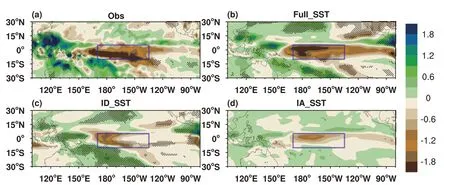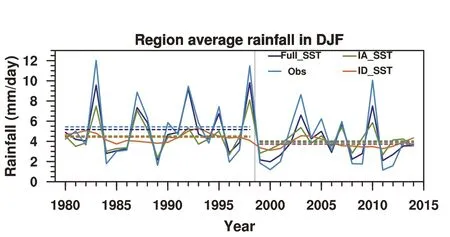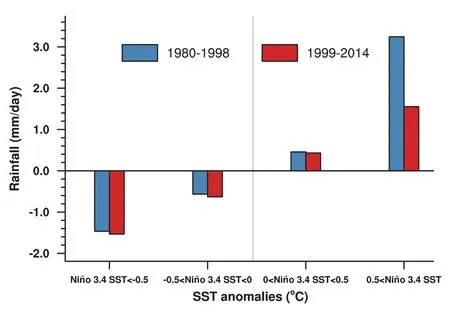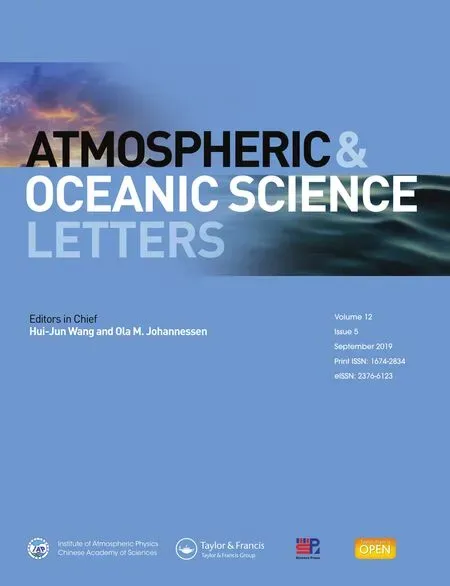Contribution of El Niño amplitude change to tropical Pacific precipitation decline in the late 1990s
GUO Suqi and WU Renguang
aCenter for Monsoon System Research, Institute of Atmospheric Physics, Chinese Academy of Sciences, Beijing, China; bCollege of Earth and Planetary Sciences, University of Chinese Academy of Sciences, Beijing, China; cState Key Laboratory of Numerical Modeling for Atmospheric Sciences and Geophysical Fluid Dynamics, Institute of Atmospheric Physics, Chinese Academy of Sciences, Beijing, China
ABSTRACT Equatorial central Pacific precipitation experienced a prominent decline in the late 1990s. This change was previously attributed to a La Niña-like mean sea surface temperature (SST)change in the Pacific Ocean associated with a phase switch of the Interdecadal Pacific Oscillation. Here, using a series of model experiments, the authors reveal that the El Niño-related interannual SST anomalies contributed largely to the precipitation decrease over the equatorial central Pacific. This El Niño SST effect was due to the change in the amplitude of El Niño events in the late 1990s. The 1980-98 decade had more large-amplitude El Niño events than the 1999-2014 decade. The nonlinear precipitation response to SST anomalies resulted in a larger decadal mean precipitation in the 1980-98 decade than in the 1999-2014 decade. The results highlight the importance of El Niño amplitude change in future climate change related to global warming.
KEYWORDS Tropical Pacific precipitation decline; Interdecadal Pacific Oscillation phase switch;interannual SST effect;largeamplitude El Niño events
1. Introduction
Interdecadal change in tropical Pacific precipitation imposes a large impact on both tropical and extratropical regions through modulating the atmospheric heating. A prominent precipitation decline occurred over the equatorial central Pacific (Dong and Lu 2013;Lyon, Barnston, and DeWitt 2014). The above tropical Pacific precipitation change was attributed to the impact of the Interdecadal Pacific Oscillation (IPO)(Dong and Lu 2013; Xiang and Wang 2013; Lyon,Barnston, and DeWitt 2014; Choi et al. 2016), an interdecadal climate mode in the Pacific Ocean (Mantua et al. 1997; Zhang, Wallace, and Battisti 1997). The IPO experienced a phase switch from positive to negative around the late 1990s, accompanied by a La Niña-like mean SST change in the tropical Pacific (Dong and Lu 2013; Lyon, Barnston, and DeWitt 2014; Choi et al.2016). The La Niña-like mean SST change led to an enhancement of the Walker circulation and associated increase in descent over the tropical central-eastern Pacific (Dong and Lu 2013; Choi et al. 2016). The above interdecadal change was linked to a westward shift in the air-sea coupling in the tropical Pacific associated with an enhanced contrast between the western and eastern tropical Pacific (Li, Hu, and Becker 2019)and the strengthening of cross-equatorial winds in the eastern Pacific that modulates the tropical Pacific mean state (Hu and Fedorov 2018).
The tropical Pacific SST variations include both interdecadal and interannual components. The observed La Niña-like SST change in the late 1990s may have included contributions of SST variations on both interdecadal and interannual time scales (Choi, An, and Yeh 2012; Sun et al. 2014). The contribution of interannual variations to the mean SST change arises from the residual effect of El Niño-Southern Oscillation associated with the El Niño-La Niña asymmetry (Rodgers,Friederichs, and Latif 2004; Yeh and Kirtman 2004; Yu and Kim 2011; Choi, An, and Yeh 2012).
The atmospheric response to El Niño and La Niña SST anomalies is nonlinear, in particular when the El Niño SST anomalies are large (Hoerling, Kumar, and Zhong 1997; Hoerling, Kumar, and Xu 2001; Chung et al. 2014; Frauen et al. 2014). This nonlinear response may result in a residual effect of interannual SST variations on the decadal mean (Liang, Yang, and Sun 2012;Sun et al.2014).As the magnitude and distribution of El Niño and La Niña SST anomalies vary from decade to decade (An and Jin 2004; Imada and Kimoto 2009; Sun and Yu 2009; Frauen and Dommenget 2010; Ogata et al. 2013), the residual decadal mean precipitation associated with the nonlinear response to El Niño SST anomalies may contribute to the interdecadal change in precipitation.
According to the previous studies reviewed above,both the decadal mean SST change and the El Niño amplitude and frequency change can contribute to the decadal mean precipitation change.An open question in this respect is what the relative contributions of interdecadal and interannual SST anomalies were to the precipitation change in the late 1990s. This issue is addressed in the present study by conducting numerical experiments using an atmospheric general circulation model (AGCM) with interdecadal and interannual SST anomalies imposed,respectively,onto the climatological annual cycle of SST. In the rest of this paper, we introduce the data and model experiments in section 2. In section 3, we compare the decadal precipitation change in boreal winter in the late-1990s in observations and model simulations.In section 4, we examine the relative contribution of different types of years to the interannual SST-related precipitation change in boreal winter.A summary and discussion are provided in section 5.
2. Data and model experiments
We use monthly precipitation from the US Climate Prediction Center Merged Analysis of Precipitation(CMAP) (Xie and Arkin 1997) provided by NOAA/OAR/ESRL PSD, Boulder, Colorado, USA, and SST from the Hadley Center Sea Ice and Sea Surface Temperature dataset (HadISST) (Rayner et al. 2003). The CMAP data have a horizontal resolution of 2.5°×2.5°and cover the period 1979-2014.The HadISST data have a horizontal resolution of 2°×2°.We use the SST for the period 1975-2017.
We conducted a suite of SST-forced experiments with the Community Atmosphere Model, version 5.1(Eaton 2012) in the F19 horizontal resolution (i.e. ~2°resolution) with 30 vertical layers. A Lanczos 2-7-year bandpass filter (Duchon 1979) was applied to the observed SST anomalies to extract their interannual component, and a 9-year low-pass filter to obtain their interdecadal component. Three sets of long-term integrations were performed to examine the impacts of total SST anomalies, interdecadal SST anomalies, and interannual SST anomalies. In the first set of experiments, the observed global SST for the period 1979-2014 was prescribed in the global ocean as the boundary condition (referred to as Full SST). In the second and third sets of experiments, the interdecadal and interannual components of SST anomalies were imposed on the observed climatological SST in the global ocean as the lower boundary condition(referred to as ID SST and IA SST, respectively). In all the experiments, atmospheric gas concentrations(including well-mixed greenhouse gases, aerosols, and ozone) were fixed at 2000 levels. Each simulation started in January 1979 and ran through March 2014.We generated eight-member simulations for each set of experiments, in which the same SST forcing was prescribed but with slightly different initial conditions. The first year of all simulations was considered as spin-up and the remaining 35 years (i.e. 1980-2014) were used in the analysis. The eight-member mean of each set of experiments was considered as the model response to the specified SST forcing.
3. Decadal precipitation change in boreal winter
The boreal winter (December-January-February, DJF)precipitation in observations displays a prominent decline over the equatorial central Pacific Ocean in the late 1990s (Figure 1(a)) (Dong and Lu 2013; Choi et al.2016). An accompanying precipitation increase is seen over the South China Sea,the Philippine Sea,and northern Australia. The model experiment with full observed SST specified in the global ocean reproduced well the precipitation decline over the equatorial central Pacific(Figure 1(b)). The location of the large precipitation decrease region shifted northward compared to the observations. The model simulated precipitation change showed discrepancies with the observations over the South China Sea, the Philippine Sea, and northern Australia, which may be attributable to the bias of the model and the lack of regional air-sea coupling in the SST specified simulation(Wu and Kirtman 2005).The airsea interaction has been shown to be important in the rainfall variability in the tropical Indo-western Pacific region(Lau and Nath 2003;Wu and Kirtman 2005,2007).

Figure 1. The difference in DJF precipitation (units: mm d-1) between 1999-2014 and 1980-98 based on the (a) CMAP data, (b)mean of eight full SST simulations, (c) mean of eight interdecadal SST simulations, and (d) mean of eight interannual SST simulations. The dotted regions denote that the precipitation difference is statistically significant at the 0.05 level according to the Student's t-test. The statistical significance in (c) was assessed assuming eight degrees of freedom. The frames denote the domains for calculating area means.
Both the interdecadal and interannual SST simulations produced a precipitation decrease over the equatorial central Pacific in the late 1990s (Figure 1(c,d)). In the interdecadal SST simulations, the precipitation decrease was confined to the region near the dateline(Figure 1(c)). The precipitation increase was simulated north and south of the equatorial western Pacific.In the interannual SST simulations, the precipitation decrease extended from the equatorial central to eastern Pacific with a reduced magnitude (Figure 1(d)). The region of the precipitation increase over the equatorial western Pacific was located more westward in the interannual SST simulations than in the interdecadal SST simulations (Figure 1(c,d)).
The time series of area-mean DJF precipitation averaged over the region (10°S-5°N, 170°E-135°W) displays large year-to-year fluctuations during the observations,as well as an interdecadal change in the late 1990s(Figure 2). The peak rainfall amount reached a larger value in the period before than after the late 1990s,which may have been associated with a larger amplitude of El Niño-related SST anomalies. The full SST simulations captured the observed year-to-year fluctuations and interdecadal change of precipitation in the region reasonably well. The maximum and minimum rainfall amounts were both underestimated - particularly for the peak rainfall amount - in the model simulations compared to the observations.Nevertheless, the model simulated the precipitation decrease over the equatorial central Pacific in the late 1990s. The time series of equatorial central Pacific precipitation showed a shift from higher to lower amounts in the late 1990s in both the interdecadal and interannual SST simulations. The year-to-year fluctuations of area-mean precipitation in the interannual SST simulations were similar to the full SST simulations and the observations. The time of peak precipitation was captured well, but the magnitude was smaller in the interannual SST simulations. The year-to-year fluctuations of area-mean precipitation were small in the interdecadal SST simulations.

Figure 2. Time series of area-mean DJF precipitation (units:mm d-1) averaged over the region (10°S-5°N, 170°E-135°W)based on the CMAP data(light blue line),mean of eight full SST simulations (navy blue line), mean of eight interdecadal SST simulations (brown line), and mean of eight interannual SST simulations (green line). The horizontal lines denote mean values during 1980-98 and 1999-2014.

Figure 3.Difference in DJF precipitation(units:mm d-1)between 1999-2014 and 1980-98 based on the mean of eight interannual SST simulations when DJF Niño3.4 SST anomalies were(a)below -0.5°C,(b)between-0.5°C and 0°C,(c)between 0°C and +0.5°C,and (d) above +0.5°C. The frames denote the domains for calculating area means.
For a quantitative comparison,we calculated the areamean DJF precipitation change from 1980-97 to 1998-2014 averaged over the region (10°S-5°N, 170°E-135°W) in the different model simulations. Based on the mean of eight simulations, the area-mean DJF precipitation change in the above region was about-1.45,-0.66,and-0.49 mm d-1in the full,interdecadal,and interannual SST simulations,respectively.This indicates that the interannual SST anomalies may contribute to about one-third of the DJF precipitation change over the equatorial central Pacific.We note that the limited number of El Niño events in the analysis period may affect the significance of the interdecadal precipitation changes in the interannual SST simulations.
4. Contribution of different types of interannual SST anomaly years
The response of precipitation and atmospheric circulation increases nonlinearly with the amplitude of equatorial central-eastern Pacific SST anomalies (Hoerling,Kumar, and Xu 2001; Chung et al. 2014; Frauen et al.2014). The nonlinearity is closely related to largeamplitude positive SST anomalies, especially when they exceed one standard deviation (Hoerling, Kumar,and Xu 2001). This leads to speculation that largeamplitude El Niño events may have made a dominant contribution to the interannual SST effect on the decadal mean precipitation decrease over the equatorial central Pacific in the late 1990s. Here, we divided the years into four categories based on DJF Niño3.4 (5°S-5°N, 170°-120°W) SST anomalies and compared the decadal precipitation change in DJF in the interannual SST simulations among the four types of years. The four categories are DJF Niño3.4 SST anomalies below -0.5°C, between -0.5°C and 0°C,between 0°C and 0.5°C, and above +0.5°C, respectively.Similarly, the decadal precipitation change was constructed as the difference between 1999-2014 and 1980-98 based on the mean of eight interannual SST simulations. We note that this study only considers the effects of the amplitude of interannual SST anomalies.The possible effects of the spatial pattern of interannual SST anomalies are not addressed.
Apparently, the precipitation difference over the equatorial central-eastern Pacific was most prominent when DJF Niño3.4 SST anomalies were above +0.5°C(Figure 3(d)). In the other three Niño3.4 SST ranges, the precipitation difference was small along the equatorial central-eastern Pacific(Figure 3(a-c)).This indicates that the interannual SST-induced decadal precipitation change was dominantly contributed by largeamplitude El Niño events.This result validates the effect of the nonlinear response of precipitation to interannual SST anomalies.We also compared the DJF precipitation change in the full SST simulations when the DJF Niño3.4 SST anomalies were within or exceeded 1.0°C(a larger value was used in determining the four ranges because the DJF Niño3.4 SST anomalies had a larger amplitude in the full SST simulations) and obtained similar results (figure not shown).

Figure 4. Area-mean DJF precipitation (units: mm d-1) anomalies during 1980-98 (blue bars) and 1999-2014 (red bars)averaged over the region (10°S-5°N, 170°E-135°W) based on the mean of eight interannual SST simulations when DJF Niño3.4 SST anomalies were below -0.5°C, between -0.5°C and 0°C, between 0°C and +0.5°C, and above +0.5°C.
The different contributions of the four types of years were further illustrated by comparing the area-mean precipitation changes. The area-mean precipitation change averaged over the equatorial central Pacific from 1980-98 to 1999-2014 was large(-1.69 mm d-1)in the case where DJF Niño3.4 SST anomalies exceeded +0.5°C, but small(-0.07, -0.07, and -0.03 mm d-1) in the cases where DJF Niño3.4 SST anomalies were below-0.5°C,between-0.5°C and 0°C,and between 0°C and 0.5°C,based on the mean of eight simulations (Figure 4). This confirms that the equatorial central Pacific precipitation decrease in the late 1990s due to the interannual SST effect was mainly associated with large-amplitude El Niño events.
5. Summary and discussion
By comparing results of numerical experiments using an AGCM with full, interdecadal, and interannual SST forcing specified, the present study shows that the interannual SST variations contributed a large part to the equatorial central Pacific precipitation decline in the late 1990s.The interannual SST effect can be attributed to the large-amplitude El Niño events. El Niño-related SST anomalies resulted in a residual decadal mean precipitation that was larger during 1980-98 with more large-amplitude El Niño events than during 1999-2014 with more weak and moderate El Niño events.
The present results imply that future warming may induce precipitation changes via two effects: one is the non-uniform mean SST change pattern;and the other is the change in the amplitude of El Niño events,which may contribute to interdecadal or long-term precipitation changes due to the nonlinear response of precipitation to El Niño-related SST anomalies. The resultant tropical Pacific precipitation changes may be accompanied by atmospheric circulation changes in remote regions through atmospheric teleconnections. Thus, the present finding has important implications for understanding future climate change in relation to global warming.
Acknowledgments
The CMAP data were obtained from https://www.esrl.noaa.gov/psd/, and the HadISST data were obtained from https://climatedataguide.ucar.edu/climate-data/sst-data-hadisst-v11/.
Disclosure statement
No potential conflict of interest was reported by the authors.
Funding
This study was supported by the National Key Research and Development Program of China [grant number 2016YFA0600603] and the National Natural Science Foundation of China [grant numbers 41775080, 41530425,41721004, and 41475081].
 Atmospheric and Oceanic Science Letters2019年5期
Atmospheric and Oceanic Science Letters2019年5期
- Atmospheric and Oceanic Science Letters的其它文章
- Enhanced correlation between ENSO and western North Pacific monsoon during boreal summer around the 1990s
- Contribution of El Niño amplitude change to tropical Pacific precipitation decline in the late 1990s
- Sub seasonal variations of weak stratospheric polar vortex in December and its impact on Eurasian air temperature
- Long-term changes in wintertime persistent heavy rainfall over southern China contributed by the Madden-Julian Oscillation
- State of China's climate in 2018
- The impacts of modeling global CO2 concentrations with GEOS-Chem using different ocean carbon fluxes
